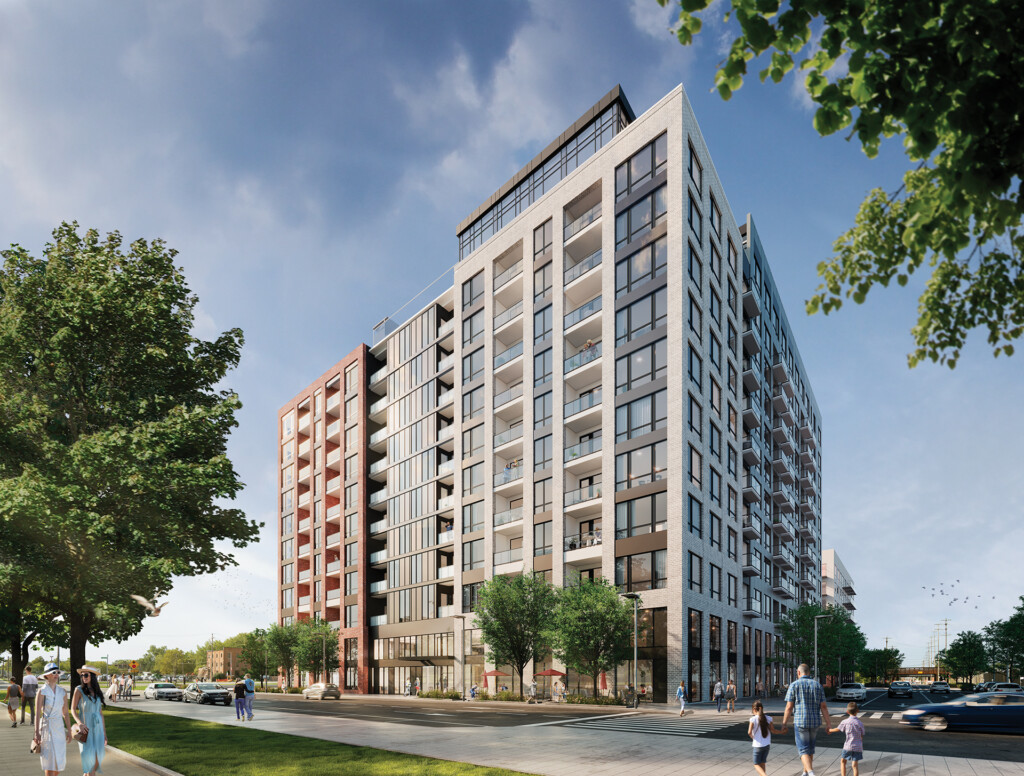By Tristan Navera Staff reporter, Columbus Business First
The first phase of a decade-long transformation of the Scioto Peninsula has begun.
Monday’s groundbreaking marks the official beginning of work on the $500 million redevelopment of 27 acres of land near COSI. The massive project, now called “The Peninsula,” will add millions of square feet in a new urban district that extends downtown to the west.
Master developer Columbus Downtown Development Corp. is starting site work this month on the project’s first phase – focused on 7 acres of land in the middle of the planned development that will include six buildings served by a 1,400 space parking garage.
“This site is second-to-none, it’s got an unparalleled view of the skyline and an adjacent park in what frankly now is a sea of parking lots,” said Guy Worley, CEO of CDDC. “This will be the most densely urban first phase of any mixed-use development in the history of our city, which will lead to higher density as demand warrants.”
The $250 million first phase of The Peninsula, to open in September 2022, includes an eight-story, 232,000 square foot speculative office building developed by Columbus-based Daimler Group Inc.; an eight-story, 132,000-square-foot, 197-key independent hotel developed by Columbus-based Rockbridge; and ONE at The Peninsula, a mixed-use development with 330 residential units and retail space developed by Indianapolis-based Flaherty & Collins Properties.
A second hotel and another 220 residential units will begin later.
The first phase of the development will build the center of the 21-acre site with future phases to follow around it
Initial ground work is beginning quickly to update utilities and build new roads that serve the site, including the central “High Water Alley” that will serve as something of a pedestrian epicenter for the project. Structural steel could start going in the ground before the end of the year too, Worley said.
As the developers have continued to work on the project, interest has remained strong even during the pandemic. The office building is the biggest speculative office building yet developed by Daimler Group, which completed downtown’s other most recent large speculative office towers, 250 S. High St. and 80 on the Commons, said Bob White Jr., president of Daimler Group.
There has been specific interest from large-block office users for the building’s 30,000-square-foot floor plates, White said, though he declined further specifics. The developer is hunting for big office users because Class A space of this size in the central business district is otherwise in short supply.
“We do have some preliminary interest from a few prospective users, and they have stuck with us during these unprecedented times,” White said. “Office needs have potentially shifted and evolved during this pandemic and we’re going to ave an opportunity to re-shape the office and re-configure it.”
So too does the hotel portion of the project remain on-track despite the pandemic’s impact on that business. Jim Merkel, CEO of Rockbridge, said the developer’s larger and more prominent first hotel will inform a second planned hotel on the site. Rockbridge is planning it to be an independent and unique business with both ground floor and rooftop elements.
“People are going to continue to want to meet and be social and that’s what we’re going to be about,” Merkel said of the hotel and its planned meeting spaces. “I’m optimistic that the situation (with the pandemic) will be very different when we’re completed and we’ll be seeing that upswing.”
Columbus will issue $30 million in bonds to finance the construction of a 1,400-space pair of parking garages serving the development. When fully built out, the project overall will have up to 2 million square feet of office space, 1,800 units of residential space, up to 400 hotel rooms and up to 200,000 square feet of retail space.
The city’s guidance to the developer has been for the project to maximize especially the office space usage of the site in order to attract more businesses to the city’s core, said Michael Stevens, the city’s director of development. Over the next 10 years as the developer adapts to the market, Stevens said it’s going to be a prime spot to expand the new office space available to serve downtown, which will extend its economic base.
The housing on the site should add to downtown’s growing population, too. Following city incentives, 10% of the housing built on the site will be affordable to those making 80% of the area median income, and another 10% will be affordable to those making 100% of the area median income.
CDDC has also put out the first video tour of the development for a sense of the intended urban feel.


